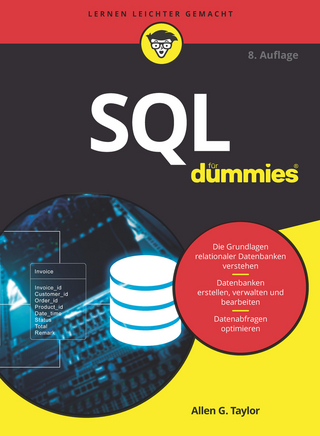
Practical Guide to Clinical Data Management
CRC Press (Verlag)
978-1-032-49558-3 (ISBN)
The management of clinical data, from its collection during a trial to its extraction for analysis, has become critical in preparing a regulatory submission and obtaining approval to market a treatment. Groundbreaking on its initial publication nearly 14 years ago, and evolving with the field in each iteration since then, this latest volume includes revisions to all chapters to reflect the recent updates to ICH E6, good clinical practices, electronic data capture, and interactive response technologies. Keeping the coverage practical, the author focuses on the most critical information that impacts clinical trial conduct, providing a full end-to-end overview for clinical data managers.
Features:
Provides an introduction and background information for the spectrum of clinical data management tasks.
Outstanding text in the industry and has been used by the Society for Clinical Data Management in creating its certification exam.
Explains the high-level flow of a clinical trial from creation of the protocol through study lock.
Reflects electronic data capture and interactive response technologies.
Discusses using the concept of three phases in the clinical data management of a study: study startup, study conduct, and study closeout, to write procedures and train staff.
Susanne Prokscha has been involved in clinical data management (CDM) processes and technologies since the mid-1980's. She has worked both as a consultant and directly for companies large and small, gaining experience with a wide range of studies and a variety of CDM systems. Since 2007, Susanne has been focusing on standard operating procedure (SOP) development, document management, and training plans for CDM and for other functions in clinical research and development.
Preface
Acknowledgements
Common Acronyms
Introduction to Clinical Trials
Testing in Humans
Clinical Trial Protocols
Clinical Trial Process
The Importance of Clinical Data Management
Regulations, Guidance, and ICH E6 (GCP)
Part I: Study Startup
Chapter 1: The Data Management Plan
Purpose of Data Management Plans
Contents of the DMP
Initiating the DMP
Approving the DMP
Revising the DMP
Using DMPs with CROs
The Value of Data Management Plans
Data Quality and DMPs
SOPs for DMPs
Chapter 2: CRF Design Considerations
Primary Goals of CRF Design
Collecting Required Data: Visits, Forms, & Fields
Collecting Analyzable Data
Protocol Compliance
CRFs Linked to Non-CRF Data
Reuse and Refine CRF Modules
Data Quality through CRF Design
SOPs on CRF Design
Chapter 3: Selecting Edit Checks
Identifying Possible Edit Checks
Focus on Critical Variables
Data Validation/Edit Check Specifications
Updating Data Validation Specifications
Data Quality through Data Validation
SOPs for Data Validation Checks
Chapter 4: EDC Study Build and Release
eCRF Build
Data Validation/Edit Check Programming
EDC Study Testing
Release to Production
Change Control
Data Quality for eCRFs and Edit Checks
SOPs on EDC Build
Chapter 5: Planning for Blinded Studies
Background on Blinding
Maintaining the Blind
Accidental Unblinding
Unblinded Study Team Members
Blinding Impacts Data Quality
SOPs and Study Plans for Blinding
Chapter 6: Patient Reported Outcomes
Background to Patient Reported Outcomes
Licensing PRO Questionnaires
Considerations for Electronic Collection
Consideration for Paper Instruments
Protocol Compliance
Budgeting Time and Money
Quality Assurance for ePRO
SOPs and Study Plans for ePRO
Part II: Study Conduct
Chapter 7: Overseeing eCRF Data Entry
Tracking Participants Enrolled
Forms Entered vs Forms Expected
Tracking Investigator Signatures
Monitoring Data Entry Benefits Data Quality
SOPs and Plans for Overseeing eCRF Data Collection
Chapter 8: Managing Queries
System Queries
Manual Queries
Tracking Open Queries
Quality Control for Queries
Using Queries to Improve Quality
SOPs and Plans for Managing Queries
Chapter 9: Collecting Adverse Event Data
Collecting AEs and SAEs
Adverse Event Forms
Storing and Cleaning AE Data
Coding Adverse Event Terms
Reconciling Serious Adverse Events
Coding and Reconciliation Approvals
Data Quality for AEs
SOPs and Study Plans for AE Data
Chapter 10: Managing Lab Data
Data Management for Lab Data
Lab Test Names
Storing Units
Lab Reference Ranges
Laboratory Identification
Central Labs
Using Specialty Labs
Data Quality for Lab Results
SOPs and Study Plans for Processing Lab Data
Chapter 11: Receiving Non-CRF Data
Receiving Electronic Files from a Vendor
Cleaning Non-CRF Data
Managing Blinded Data
Data Quality for External Data
SOPs and Study Plans for Non-CRF Data
Chapter 12: Data Review
Edit Checks vs Data Review
Data Review Plan
Performing Data Review
Planning for Manual Queries
Data Quality and Manual Data Reviews
SOPs and Study Plans for Data Review
Chapter 13: Risk-Based Quality Management
Background
A Structure for Risk-Based Quality Management
Centralized Monitoring
Working with Clinical Operations
RBQM is Quality Assurance
SOPs and Study Plans for RBQM
Chapter 14: Managing EDC Changes
Change Control for Studies
eCRF Changes
Edit Check Changes
Other Study Changes
Testing and Approval
Impact on Investigator Signatures
Changes Associated with a Protocol Amendment
Maintaining Data Quality during EDC Study Changes
SOPs for EDC Changes
Part III: Study Lock
Chapter 15: Study Lock
Core Requirements for Study Lock
Final Study Lock
Interim Study Lock
Data Extract Plans or Specifications
Soft Lock
Time to Study Database Lock
Final Data Quality
SOPs and Study Plans for Study Locks
Chapter 16: After Study Lock
Post-Lock Activities
Unlocking EDC Studies
Data Quality and TMF Quality
SOPs and Sutdy Plans for Post-Lock and Unlock
Part IV: Necessary Infrastructure
Chapter 17: SOPs for CDM
What Is an SOP?
SOPs for Data Management
Creating SOPs
Complying with SOPs
SOP on SOPs
Quality Assurance through SOP Revisions
Chapter 18: CDM and the TMF
TMF Reference Model
Reviewing the Study Reference Model
Submitting to the TMF
TMF QC
Supporting Documents, Email, and NTFs
Living with the TMF
Chapter 19: Training
Minimum Required Training
Training Matrices
How to Train
Training Records
Experience and Education
Allotting Time for Training
SOPs on Training
Chapter 20: User Management
Account Management
Access Control through Roles
Taking Security Seriously
SOPs and Guidelines for Accounts
Chapter 21: Developing and Using Standards
The Goal and Purpose of Standards/
Industry Standards
Where to Start
Standards Team Governance
Using Standards
SOPs for Standards
Chapter 22: Working with Service Providers
Data Management CROs
The CRO Myth
Qualifying CROs
Defining Responsibilities
Oversight Metrics
Oversight During the Trial
Resourcing
EDC Vendors as CROs
Functional Service Providers
Benefiting from CROs
SOPs for working with CROs
Part V: Using Computerized Systems
Chapter 23: Data Integrity
What is Data Integrity?
Integrity in the Data Lifecycle
Demonstrating Integrity in Transfers
Applying Risk Assessments
Chapter 24: Data in EDC Systems
Control of Data: Hosting
Data Entry by the Sponsor or CRO
Need for Data Repositories
Chapter 25: Choosing Vendor Systems
Defining Business Needs
Initial Data Gathering
Extended Demos and Pilots
Additional Considerations
What is Missing?
Qualifying a Vendor
Preparing for Implementation
Chapter 26: Implementation Planning
Overview and Related Plans
Essential Preparation
Validation
Integration and Extensions
Migration of Legacy Data
Benefiting from Pilots
Assessing SOPs and Other Documents
Preparation for Production
Successful Implementation
Chapter 27: System Validation
What Is System Validation?
Systems that Require Validation
Validation for Hosted Systems
Validation Plan
Validation Testing
Validation Report
Change Control
Requirements and Benefits
Chapter 28: Migrating and Archiving Data
Regulatory Expectations
When to Migrate
EDC Migrations
Complex Migrations
Migration by Re-Entry
Audit Trails in Migrations
Archiving and Decommissioning
Migration and Archive Plans
Data Integrity for Migrations and Archives
Chapter 29: EDC Study Rebuilds
Circumstances Leading to Rebuilds
eCRF and Edit Check Rebuild
Moving Data
Investigator Signatures
Integrated Systems
Site Impact
Documentation
Appendix A: Data Management Plan Template
Appendix B: Data Extract Plan Template
Appendix C: System Implementation Outline
Index
| Erscheinungsdatum | 10.07.2024 |
|---|---|
| Zusatzinfo | 24 Line drawings, black and white; 24 Illustrations, black and white |
| Verlagsort | London |
| Sprache | englisch |
| Maße | 156 x 234 mm |
| Gewicht | 453 g |
| Themenwelt | Mathematik / Informatik ► Informatik ► Datenbanken |
| Mathematik / Informatik ► Informatik ► Theorie / Studium | |
| Medizin / Pharmazie | |
| Naturwissenschaften ► Biologie | |
| ISBN-10 | 1-032-49558-8 / 1032495588 |
| ISBN-13 | 978-1-032-49558-3 / 9781032495583 |
| Zustand | Neuware |
| Informationen gemäß Produktsicherheitsverordnung (GPSR) | |
| Haben Sie eine Frage zum Produkt? |
aus dem Bereich


